Soil preference:Fertile but free-draining
Aspect:Sun
Season of interest:Summer
Height and spread:Variable to 2m × 45cm (6ft × 1ft 6in)
Companion plants:Fast-growing plants whose soft, lacy foliage provides a gentle tracery, striking when accompanied by bedding such as annual Lavetera, petunias or dense masses of fuchsias. Also pretty dotted in a flower border, perhaps with cleomes.
Dahlia
Half hardy perennials
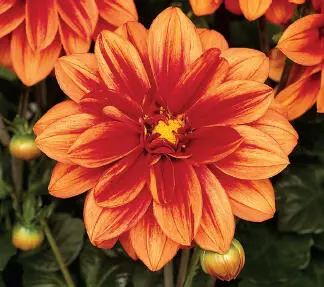
A variable genus with huge plants, bearing vast blooms the size of a hat down to more modest, dwarf varieties. Many-branched stems rise from fleshy tubers in late spring and are furnished with divided, glossy, sometimes dark foliage. The late summer flowers are variable, usually brightly coloured with every hue except pure blue. Seed series such as ‘Duo’ or the dark-leaved ‘Bishop’s Children’ are good for bedding.
Soil preference:Any fertile, free-draining but not too dry
Aspect:Sun
Season of interest:Summer, autumn
Height and spread:Variable to 2m × 75cm (6ft × 2ft 6in)
Companion plants:Medium and small flowered varieties, especially those with dark foliage, are popular, blending with lilies among shrubs or in a late summer border with heleniums, late daisies or chrysanthemums.
Bedding Schemes Used Formally and Informally
Bedding schemes can be tailored to suit a diverse range of tastes and preferences. Plants, in formal bedding, are used en masse to create a colourful surface and their use can appear to be more akin to painting than to planting! Bold brush-strokes of colour, sometimes creating formal patterns or shapes, often in the commemoration of an event, are popular in public planting schemes and are intended to provide sudden drama and spectacle, rather than to sustain a gentle, changing scene.
However, bedding can also be used in an informal way, simply arranging for drifts of similar plants to make small statements, perhaps as part of a border, or for giving temporary lift to an otherwise dull spot.
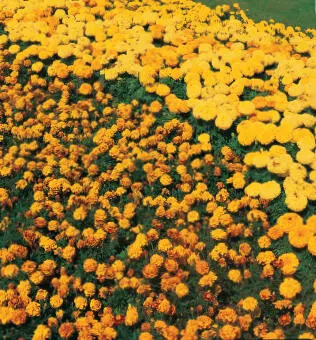
Vibrant colours
The main picture opposite shows a harmonious spring bedding display using botanical tulips, Tulipa kaufmanniana ‘Stresa’, with Hyacinthus orientalis ‘Blue Jacket’. The three strong colours, red, yellow and blue, work superbly together and bring bright spring cheer. The display will not be long-lived, however, and will leave a sizeable gap by the end of spring.
Painting with flowers
In this scheme (see the bottom picture on the opposite page), bold swirls of Tagetes (French and African marigolds) create a dazzling surface which is so intense in colour that it can almost cause physical discomfort to view, particularly in low light conditions. However, where the sun is strong, hard colours like these can be surprisingly effective. The effect is one of drama, rather than to entice long, lingering looks!
Using dot plants to lift the scheme
Common bedding plants such as these Ageratum (above) can be augmented with less usual choices to add interest to an otherwise rather pedestrian planting scheme. The Verbascums are used here for the silver foliage but later they will produce handsome flower spikes and make strong accent plants.
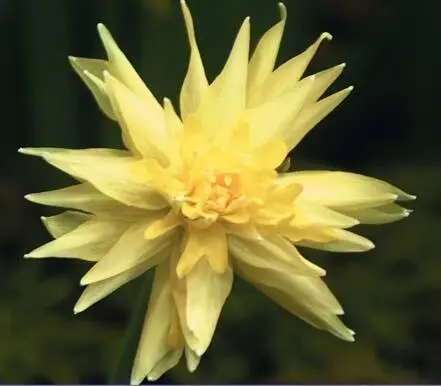
Bulbs: medium and tall for spring
Dwarf bulbs for winter and spring
Focus on… Narcissus
Bulbs: medium and tall for summer
Bulbs: medium and tall for spring
Fritillaria imperialis
Crown Imperial Hardy bulb
Largest of the fritillaries and ancient in cultivation. Big, pungent-smelling bulbs producing thick, fleshy stems, furnished with glossy, narrow leaves along their length. At their tips, clusters of large, dark-veined, orange or yellow bell-shaped flowers form below a topknot of foliage. The petal bases have glands which drip tears of nectar.
Soil preference:Any, well-drained
Aspect:Sun or part shade
Season of interest:Spring
Height and spread:1m × 45cm (3ft 3in × 1ft 6in)
Companion plants:Big, bold spring plants for dotting among developing summer perennials or to naturalize among such ornamental trees as cherries, crab apples or hawthorns.
Fritillaria pallidiflora
Hardy bulb
A variable species with paired, narrow, grey-green leaves and thin stems which bear groups of two, three or four cup-shaped nodding flowers in a pale beige to creamy primrose. The bulbs are slow to increase and so work better in small groups than singly.
Soil preference:Any free-draining, but not too dry
Aspect:Sun or part shade
Season of interest:Spring
Height and spread:To 45cm × 10cm (1ft 6in × 4in)
Companion plants:Superb when grown with other fritillaries and late spring flowers. Species tulips such as Tulipa sprengeri and T. acuminata go well, as does Fritillaria verticillata .
Hyacinthoides non-scripta
English Bluebell Hardy bulb

Dark, glossy, narrow foliage begins to emerge in early spring. The flower stems extend in mid spring, and carry clusters of hanging, bell-shaped, fragrant, dark blue flowers. Albino and pink forms also occur but are rare. Successful growth depends on a relationship the plants have with micro-organisms in the soil, and establishment can be difficult. Plant ‘in the green’ (ie. in leaf).
Soil preference:Woodland soil, high in organic matter
Aspect:Shade or part shade
Season of interest:Spring
Height and spread:To 45cm × 10cm (1ft 6in × 4in)
Companion plants:Suitable for naturalizing in shady places and beautiful with wood anemones, ragged robin, primulas or red campion.
Erythronium ‘Pagoda’
Dog’s Tooth Violet Hardy bulb
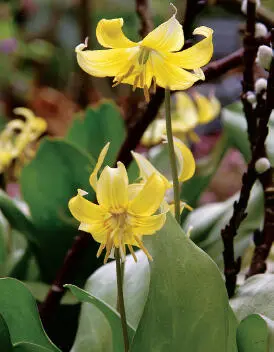
A garden hybrid with broad, richly decorated, glossy foliage, which creates a fine base for the sprays of elegant flowers. These are up to 5cm (2in) across, with pale yellow petals which curl to create a pagoda effect.
Soil preference:Woodland soil, rich in organic matter
Aspect:Shade or part shade
Season of interest:Spring
Height and spread:30cm × 25cm (1ft × 10in)
Companion plants:Fine when naturalised in a shady border or woodland garden, especially with bluebells, Uvularia and epimediums.
Ornithogalum nutans
Star of Bethlehem Hardy bulb
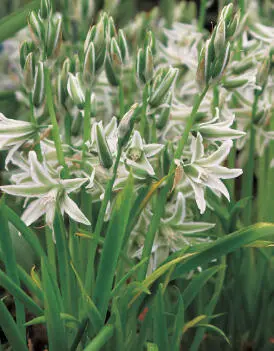
Narrow, grassy, rather lax foliage and erect, glossy stems which end with generous spikes of hanging flowers whose almost translucent white petals are lined with a pale green stripes. Thrives in a hot, dry spot on poor soil, but the flowers tend to be short-lived.
Читать дальше


















